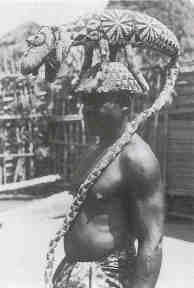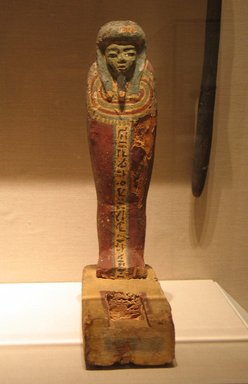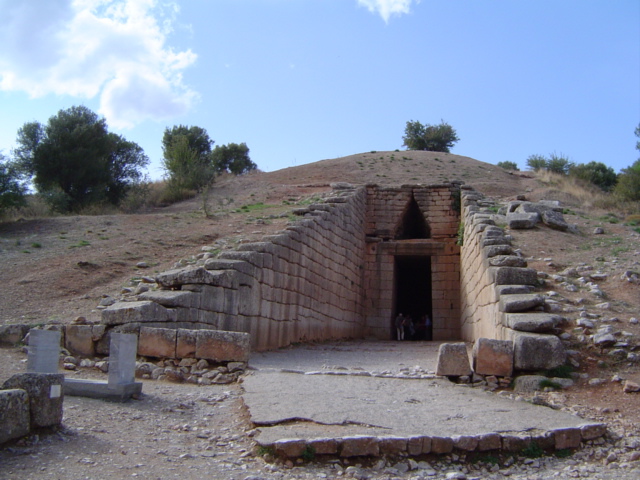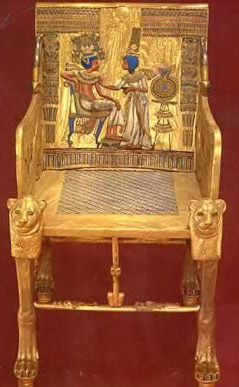African Art
Jacques Paye

-
19th–20th century
-
Cameroon, Western
-
Bamileke
-
Cotton, glass beads, wood
-
154.9 x 62.2 cm
Aka Elephant Mask

Cultural Context: Bamileke
Content: Elephant
Formal Aspects: Hatching, colors blended, beads
Function: Masquerade
Aka Elephant Mask:

Aka Elephant Mask

Bamileke masquerader with a
beaded Leopard crest

Aka Elephant Mask
LEOPARD HEAD PIECE
Collected by A. Diehl in Batcham, 1911
75265, L. 19 in. (48 1/2 cm)
Beads of four sizes; colours: white, light green, red

-
Date: mid-18th to mid-19th century
-
Southern Cameroon
-
Fang
-
Wood, Iron
-
Dimensions: 58.4 x 14.9 x 12.7 cm
Reliquary figure (byeri)

Cultural Context: Fang, ancestor worship
Content: Male ancestor figure
Formal Aspects: Highly stylized
Function: Attached to skull basket, ancestor worship
Reliquary figure (byeri)

Reliquary figure (byeri)

Mummiform Figure, after 305 B.C.E. Wood, paint, 14 1/4 x 3 9/16 x 9 1/8 in. (36.2 x 9 x 23.2 cm). Brooklyn Museum, Charles Edwin Wilbour Fund

Fang. Reliquary Guardian Figure (Eyema-O-Byeri), 19th-20th century. Wood, 21 1/2 x 5 1/2 x 7 1/2 in. (? x 14.0 x 19.0 cm). Brooklyn Museum, The Adolph and Esther D. Gottlieb Collection
-
Late 19/Early 20th century
-
DRC
-
Chokwe
-
Wood, Plant Fiber, Copper
-
Dimensions: 39.1 x 21.3 x 23.5 cm
Female (Pwo) Mask

Cultural Context: Chokwe, central Africa
Content: Founding female ancestor
Formal Aspects: Highly stylized
Function: Used by male to play role of female ancestor
Female (Pwo) Mask:

Female (Pwo) Mask:

Date: 19th–early 20th century
Geography: Angola, Xassenge region
Culture: Chokwe peoples
Medium: Wood, fiber, brass, pigment
Dimensions: H. 10 5/8 x W. 7 in. (27 x 17.8 cm)
Female (Pwo) Mask:

The Death Mask of Tutankhamun
-
19th/20th century CE
-
Sierra Leone
-
Mende
-
Polished hardwood
Bundu Mask

Cultural Context: Sande secret society
Content: Ancestral spirit with female features
Formal Aspects: Stylized, intricately carved
Function: Used as formal disguise during most important Sande rituals.
Bundu Mask:

Bundu Mask:

Akkadian bronze head, found in Nineveh, perhaps head of Akkadian king Sargon of Akkad

A Bundu mask in a slightly different style.
-
1000-1400 CE
-
Southeastern Zimbabwe
-
Granite blocks
-
Shona peoples
Conical tower and circular wall of Great Zimbabwe

Conical tower and circular wall of Great Zimbabwe

Cultural Context: Ancestors of Shona
Content: Great Enclosure, 33-foot tall tower.
Formal Aspects: Excellent stonework, potentially symbolic structures
Function: Capital of kingdom, seat of royalty, up to 18,000 inhabitants.
Conical tower and circular wall of Great Zimbabwe

Dromos entrance to the Treasury of Atreus

The tower at Gonbad. Mausoleum of powerful regional warlord.
-
founded c. 1200 CE
-
Rebuilt 1906-1907
-
Mali
-
Adobe
Great Mosque of Djenné

Great Mosque of Djenné

Cultural Context: Sudano-Sahelian
Content: Enormous adobe structure
Formal Aspects: Sun-baked bricks covered with mud coating. Decorative palm.
Function: Islamic mosque. Repaired every year.
Great Mosque of Djenné

White Temple and its ziggurat. Uruk (modern Warka, Iraq). Sumerian. c. 3500–3000 B.C.E. Mud brick.

Tomb of Askia Mohammad I, modern-day Gao, Mali. 1495, mud and wood imported from Mecca.
-
c. 1700 CE
-
South central Ghana
-
Adobe
-
Ashanti peoples
-
Gold over wood and cast-gold attachments
Sika dwa kofi (Golden Stool)

Sika dwa kofi (Golden Stool)

Cultural Context: Ashanti people
Content: Curved seat. Hanging bells.
Formal Aspects: Wooden, covered with gold. Gold is color of royalty.
Function: Stool allegedly fell from sky onto lap of Osei Tutu. Believed to house spirit of nation.
Sika dwa kofi (Golden Stool)
"Elgin Throne"
Artist/Maker(s): Unknown
Culture: Greek
Place(s): Athens, Greece (Place found)
Date: 4th century B.C.
Medium: Marble

Throne of King Tutankhamun.
Valley of Kings, Egypt. ca. 1323 BCE
Sources:
- http://museum.dma.org/idc/idcplg?IdcService=SS_QD_GET_RENDITION&coreContentOnly=1&dDocName=dmacon_elephant_mask&dID=4957#m
- http://www.randafricanart.com/Bamileke_elephant_and_leopard_headcrests.html
- http://www.metmuseum.org/collection/the-collection-online/search/319264
- http://mv.vatican.va/3_EN/pages/x-Schede/METs/METs_Sala03_02_02_027.html
- http://whc.unesco.org/en/list/364